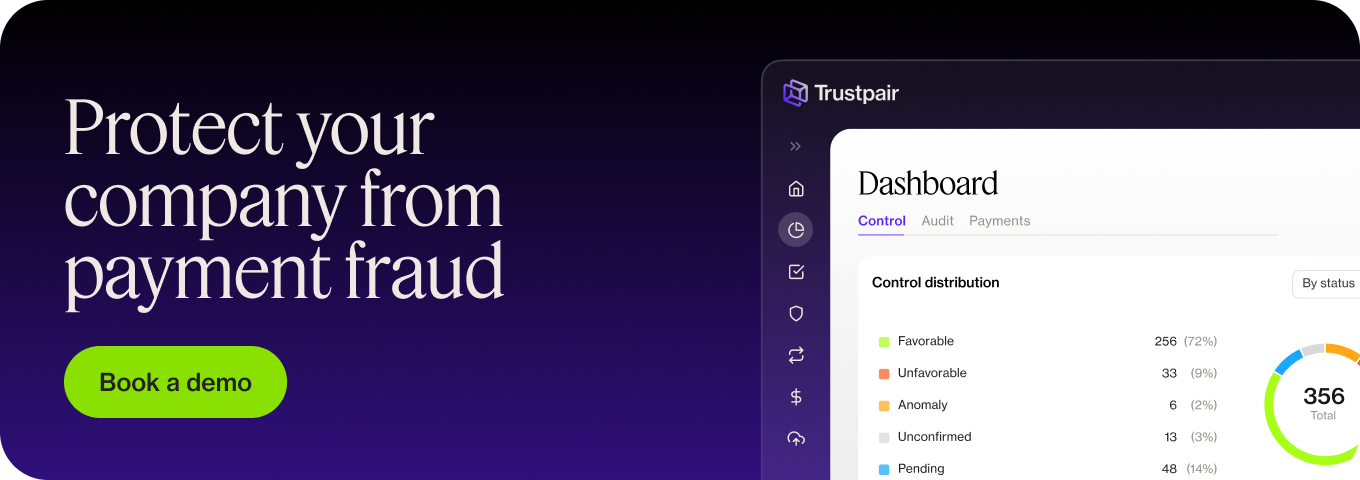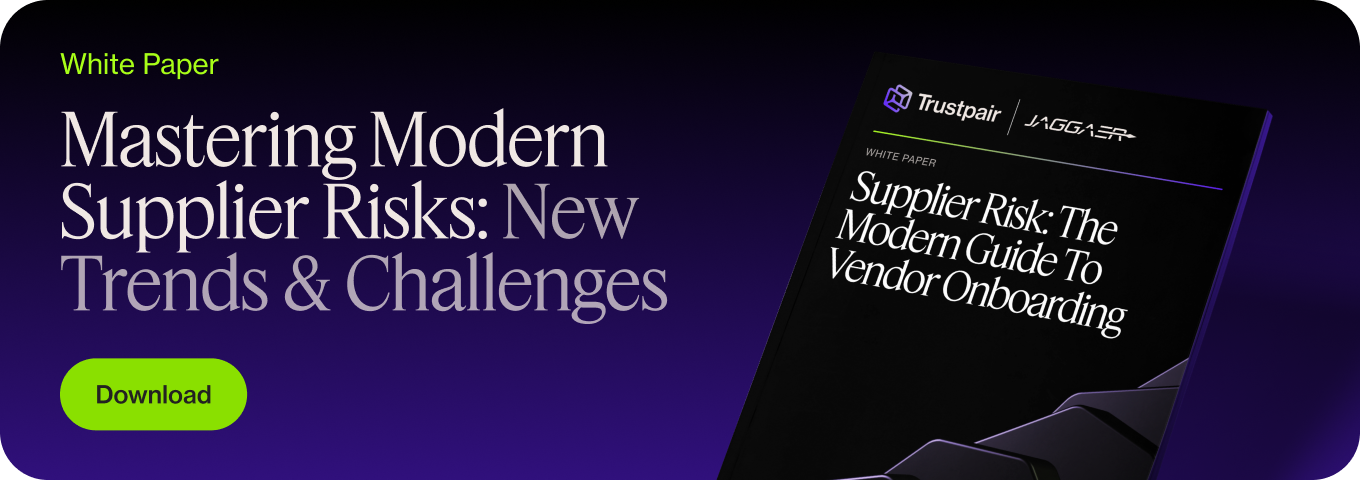24% of companies that were victims of payment fraud last year lost over $100,000, and 5% lost more than $1 million. A third-party risk assessment can help your company prevent these losses, and protect it from fraud. A thoughtful third-party risk strategy can help your business effectively fight against fraud. Suddenly, investment in anti-fraud software might not sound so expensive in the face of such losses.
Trustpair is the ultimate fraud risk management tool. We block fraud by continuously controlling supplier data and payment campaigns before they are executed. Contact an expert to learn more!
What is a third-party risk assessment?
Third-party risk assessments help to mitigate your organization against any potential side effects of doing business with others.
Third-party risk assessment, a definition
In every business, general risk assessments are used during the due diligence process, in order to explore threats and later act to protect any vulnerabilities. But third-party vendor risk assessments particularly focus on your connections to customers, merchants, and vendors across the supply chain.
These relationships require a risk assessment because the actions of your third parties can reflect directly on your business. It’s therefore important to find out how they operate in order to eliminate the possible negative effects on your company.
What is general risk management?
In a broader sense, risk management describes the process of mitigating the impacts of any risks found. Most risk assessments grade each risk scenario against the likelihood of occurrence and level of impact.
For example, a risk would include data breaches and the subsequent vendor risk management program might include upgrading your cybersecurity software, creating Standard Operating Procedures (SOPs) for cyber, or creating information security policies.
Supplier risk management practices help your people prioritize each vulnerability and implement strategies to prevent them.
What are the types of third-party risk?
Working with an external provider brings numerous risks to your business. These include:
- Cybersecurity
- Financial
- Reputational
- Regulatory
- Business
- Operational
Cybersecurity Risks
Most companies use digital programs, like email or social media, to relate to their ideal customer. But the internet is not infallible – and many fraudsters use online channels to attack businesses. Therefore, cyber and security risks refer to all of the possibilities connected to your business through the Internet.
One example of a cybersecurity risk is business email compromise (BEC). If your third parties don’t have measures to protect against this, hackers could intercept their email communications or take over their whole system with the single click of a malware link. This incident then increases the risks for your own organization, since scammers might try to climb the supply chain back to you.
And in the case of vendor fraud, you might end up paying the wrong person without even knowing about it. Typically, fraudsters send an email requesting changes in banking information by impersonating one of your real suppliers. Payment fraud prevention platforms like Trustpair effectively block this situation from happening because we continuously verify and manage third party account information.
Financial Risks
Financial risks describe the possibility that your company will lose money after entering into a partnership. The financial risk management process therefore describes the mitigation of these risks turning into actual events, saving your company the money.
For example, let’s imagine you’re defrauded by a fake supplier. By paying them, you’ve effectively lost the money that should have been used to pay the real supplier.
Reputational Risks
Reputations in any industry can take years, if not decades, to build. But they can be destroyed in an instant if you partner with the wrong third party.
Just take the example of Arthur Anderson LLP, one of the top five accounting firms in the US. But as the accountants for Enron, after the scandal broke, the company lost their reputation around high standards and has since disappeared into the fray.
Regulatory Risks
When assessing various suppliers, you need to ensure that they comply with any regulations your business might be subjected to, such as anti-money laundering laws or SOX Law. Then, it’s about facilitating compliance management. Otherwise, you could risk not meeting regulatory requirements, financial penalties, and civil proceedings if your partners are deemed non-compliant.
For example, here at Trustpair, we’re compliant with SOX Law – allowing us to work with publicly-traded companies in fraud risk management.
Business Risks
Business risks refer to the strategic company decisions at risk when you choose to partner with a third party. Before you sign on the dotted line, it’s important to consider whether working together could prevent your organization from achieving its strategy for growth, or future goals.
One example of a business risk would be an undiscovered conflict of interest – it could hamper your progress if your supplier was also working with a competitor, for example.
Operational Risks
Finally, operational risks are those which would prevent your business from day-to-day running. It’s about business continuity. The consequences of such risks could be catastrophic, as they prevent you from re-gaining any of the money or reputation lost. So mitigation is important.
One key example is if one merchant supplies a particular good or service for your product output, and the shipment doesn’t arrive. Without a contingency plan, your staff could be stuck waiting for the delivery for days or weeks while the inventory has run out, preventing the company from more sales.
Why is third-party risk assessment important?
A third-party risk assessment informs you of the specific situations with your partners, rather than the broader market risks. It allows your auditors to delve into third-party operations, to actually reveal all of the possible risks and the stakes at play. Then, determine whether the partnership is worth it anyway. It can also help your teams come up with strategies to protect against the risks, lessening the impact if they materialize.
Moreover, a third-party risk assessment is often essential for compliance with major regulations. Without proof of third-party compliance, companies risk being non-compliant themselves as they operate with their partners.
One prominent example of a business that suffered from fraud in one of their partners, is Target. Their HVAC (heating, ventilation, and air conditioning) vendor was hacked in a business email compromise scam. The fraudsters used their access to send an email containing malware. Unfortunately, an unsuspecting employee clicked on the link, inadvertently causing a data breach.
In total, the debit and credit card data of 40 million customers, and further personal information of around 70 million customers fell into the hands of the fraudsters. This also led to regulatory investigations, reputational damage, and court proceedings which cost the company millions.
A secure vendor onboarding is the first step to an efficient third-party risk management strategy. Download our white paper to learn more!
What are the best practices of third-party risk assessment?
Here is the step-by-step process for a third-party risk assessment:
- Reach out to vendors with a risk questionnaire
- Develop risk criteria and detection methods
- Set risk tolerance and deviation
After your third-party risk assessment is complete, your team can move on to risk prevention strategies in order to protect the business and vendor security.
Risk Questionnaire
A risk questionnaire should help to inform your team about the practices going on with potential third parties. Alongside asking broadly about the risks they have identified, it could be worth finding out about prevention strategies that they have in place. Here are some more questions you can ask:
- Are you GDPR certified?
- How frequently do you back up your data?
- Are your systems encrypted? With what software?
It’s through these questions and more that you can identify the relevant risks.
Risk criteria and detection methods
Once the risks have been identified, they should be graded as part of your risk criteria. Which risks are too much for your company to bear, and which ones can be easily contained?
Under risk analysis, most businesses consider the impacts and likelihood of occurrence to grade the risks from most concerning to least.
It’s also important to set up fraud detection methods for each of the risks identified. This gives you the greatest chance of spotting events as soon as they happen and reacting before the impacts can go too far.
For example, Trustpair runs continuous bank account validation on third parties to ensure that your payment system isn’t compromised. Even when a change of account details is requested, our comprehensive database compares the new details to company, financial, and location data to ensure your payments go to legitimate partners. Therefore, the third party fraud risk is entirely wiped out.
Risk tolerance and deviation
Risk tolerance refers to the level of risk that your business is comfortable with. When you bring on a new third party, they should already qualify, being within this level of risk tolerance.
Thus, deviation refers to the changes in risk levels, and how much your company can take before you have to end the partnership. Your accountants can form a statistical model in order to capture changes in risk and notify you when a partnership exceeds the boundaries.
Why is using software the most effective way to manage third-party risk?
Using software allows your company to oversee third-party risks. Automation, in particular, makes it possible to continuously monitor the risks, track any changes, and respond immediately.
Trustpair facilitates vendor management through the validation of international accounts. With the best coverage rate in the USA, Europe, and China, we can authenticate physical and legal entities worldwide, as well as trace back any changes to the security controls on your side. What’s more, you can use Trustpair to digitize processes with third parties, integrating your flow of data from third parties to your platform.
Demo Trustpair to experience the automatic, real-time screening of third-party data.
In summary
A third-party risk assessment can offer insight into the financial health of your business, including building a risk profile for each vendor. Risk management software like Trustpair is the best way to protect your company against supplier risks, including access control and preventing security breaches.






